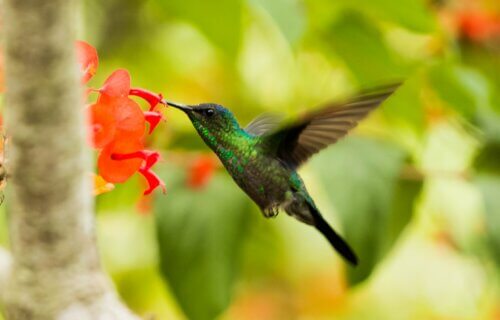STORRS, Conn. — Hummingbirds could be the next casualty of global warming, a new study warns. Researchers say they will have to move north to seek cooler climes, or the species will go extinct.
Hummingbirds perform the most exhausting type of flight in the animal kingdom. Their habit of hovering demands far more energy and oxygen than conventional flight. Yet, thin air poses no barrier to these birds. They thrive atop high mountain ranges from, Alaska to South America.
However, the new study found the challenges of relocating may be too much for the agile little aeronauts.
“Overall, our results suggest lower oxygen availability and low air pressure may be difficult challenges to overcome for hummingbirds shifting upslope as a consequence of rising temperatures, especially if there is little to no long-term acclimatization,” lead author Austin Spence from the University of Connecticut and the team writes in the Journal of Experimental Biology.

Thinner and colder air is particularly problematic for creatures struggling to keep warm when less oxygen is available. The study focused on Anna’s hummingbirds which are comfortable up to elevations of around 9,000 feet.
Researchers lured the hummingbirds into net traps from sites in California, ranging from 30 feet above sea level in Sacramento up to 7,800 feet in Mammoth Lakes. Then, the team transported them to an aviary in western California at nearly 4,000 feet.
Once the birds spent a few days in their new home, a tiny funnel was set up into which they could insert their heads as they hovered while sipping tasty syrup. Study authors measured metabolic rates overnight as the tiny creatures allowed their metabolism to tumble when they became “torpid.”
The form of mini-hibernation conserves energy during sleep. Hummingbirds can cool their bodies to less than 40°F at night, the lowest temperature recorded in any bird. They have wings that beat more than 10 times a second. During daylight, they use their hovering ability to suck nectar from thousands of flowers. To keep up, their tiny hearts beat around 1,000 times a minute, but this drops to just 50 during torpor.
Next, Spence and colleagues relocated the birds to a nearby research station 12,500 feet up near the peak of Mount Barcroft. The air is thinner with roughly 39 percent less oxygen and about five degrees Celsius colder. After four days at the new altitude, the team assessed metabolic rates again.
The hovering hummingbirds should have been working harder to remain aloft in the thin air 3,300 feet above their natural range. Instead, they actually experienced a 37-percent drop in metabolic rate. When the team compared the energy used by birds that originated close to sea level and from the higher end of their range, they all struggled equally on the mountain top.
Moreover, the birds resorted to dropping their metabolic rate for lengthier periods at night. They spent more than 87.5 percent of the chilly high-altitude night in torpor.
“It means that even if they are from a warm or cool spot, they use torpor when its super-cold, which is cool,” Spence says, according to a statement from SWNS.
The team also checked the size of the animals’ lungs to find out whether they got bigger compared to those that originated from higher altitudes to compensate for meager oxygen supply. They did not. However, the birds did have larger hearts to circulate oxygen around the body. The findings have implications for their future as they seek more comfortable conditions due to climate change.
South West News Service writer Mark Waghorn contributed to this report.

BS
Leftists LIE, a lot! Silly you–don’t you understand that by now?
I call this study B.S. I don’t believe it has any basis in fact.
total BS…..we have lived in scottsdale for 17 years,,,, and the hummingbirds are more prevalent now than when we moved here…they show NO signs of going anywhere..
.
It’s a poorly written article. They aren’t saying all hummingbird species everywhere will go extinct because of climate change, they’re saying some species may not be able to adapt to the higher elevations that may be required to escape warming regions. Some species, in some areas.
Anna’s Hummingbird is probably the most hardy of all, and is not in any danger. It’s able to overwinter in Portland and Seattle without problem, and has already shifted well north.